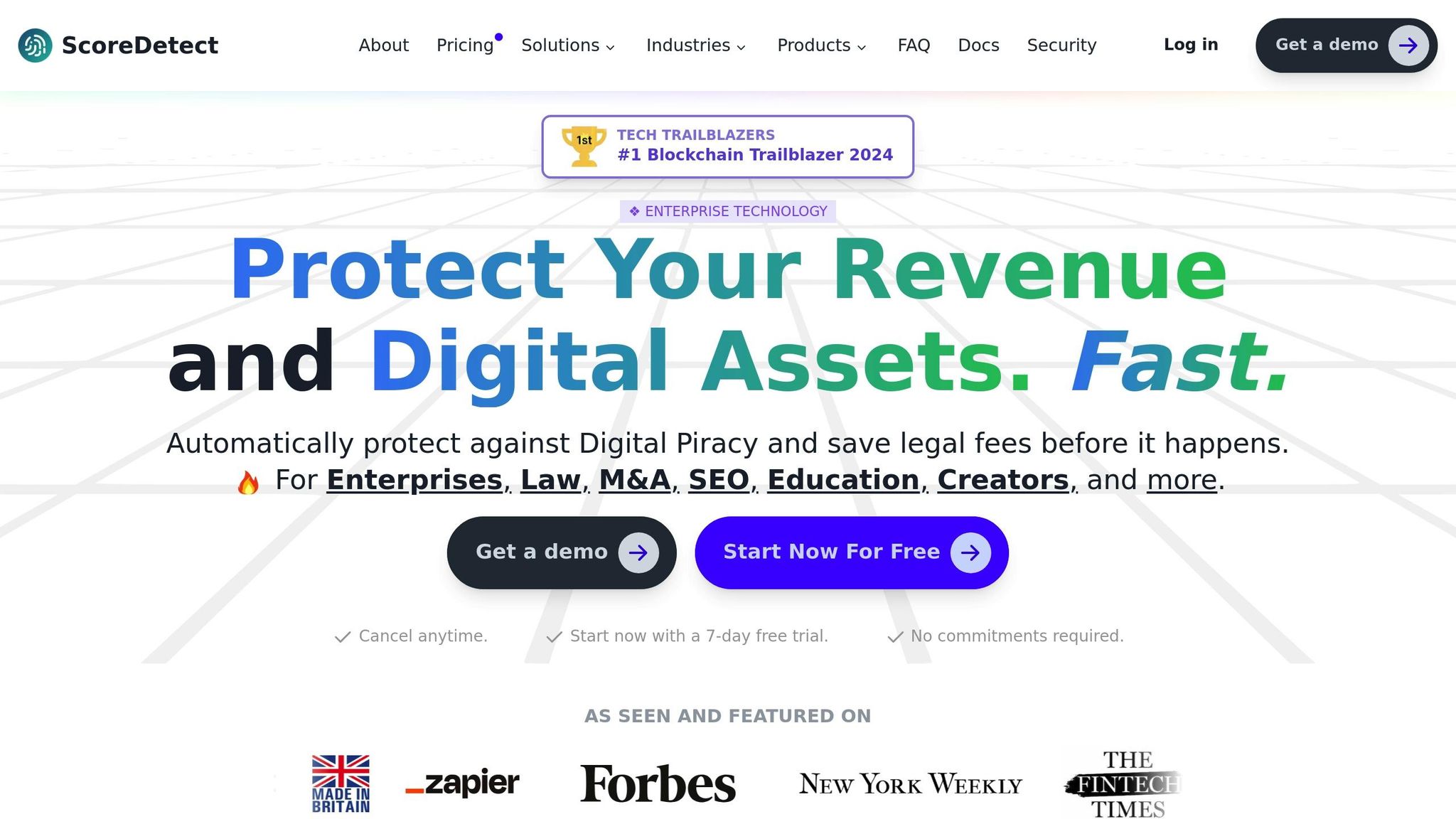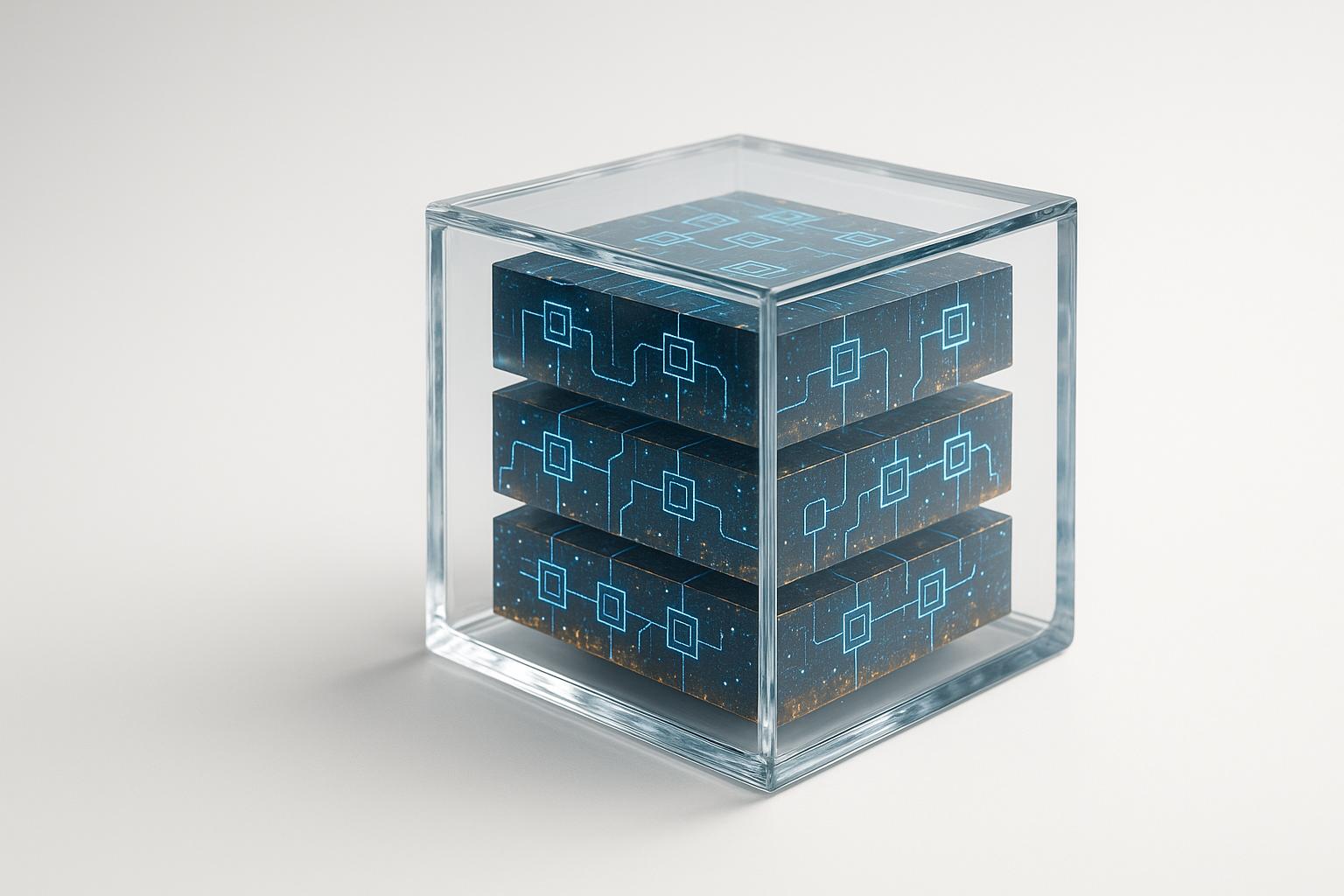The WIPO Copyright Treaty (WCT), established in 1996, modernized copyright laws to address challenges in the digital age. It provides tools to combat digital piracy, such as Technological Protection Measures (TPMs) and Rights Management Information (RMI), ensuring content creators can protect their work across borders. However, enforcement faces hurdles like cross-border jurisdiction issues, platform accountability, and the anonymity of online users. Advanced solutions like watermarking, blockchain, and automated enforcement platforms (e.g., ScoreDetect) help address these gaps, but global collaboration and consistent application of laws remain critical.
The Effectiveness of the WIPO Copyright Treaty in Dealing with Digital Piracy in the United States
Main Provisions That Target Digital Piracy
The WIPO Copyright Treaty (WCT) lays out two key measures aimed at tackling digital piracy, equipping copyright holders with tools to safeguard their digital content and track unauthorized use effectively.
Technological Protection Measures (TPMs)
Technological Protection Measures are digital tools designed to regulate how content is accessed, copied, or shared. Think of them as virtual locks that prevent unauthorized use. The WCT mandates that all member countries enforce legal protections against attempts to bypass these measures.
Under Article 11 of the treaty, circumventing TPMs is a legal offense. This includes breaking through digital protections like DRM (Digital Rights Management), encryption, or watermarking. The United States addressed this with the Digital Millennium Copyright Act (DMCA) of 1998, which prohibits actions like decrypting DVDs to copy their content or creating software to remove DRM from music or videos. For instance, anyone bypassing streaming service protections or distributing tools to crack these systems violates U.S. law under the DMCA [3].
The effectiveness of TPMs is evident in real-world applications. For example, Netflix reported a 30% drop in piracy-related traffic after strengthening its DRM in 2021, showcasing how robust measures can deter illegal activity [5].
One advanced TPM method is watermarking. This technology embeds unique markers into digital content, allowing copyright holders to trace unauthorized distribution back to its source. Unlike traditional DRM, which restricts access, watermarking permits regular use while providing evidence if piracy occurs.
Platforms like ScoreDetect highlight how watermarking supports the WCT’s goals. By embedding markers that track distribution patterns, ScoreDetect helps identify and address unauthorized sharing. Combined with strong TPMs, this approach creates a multi-layered protection system for digital content.
Rights Management Information (RMI) Protection
Rights Management Information (RMI) refers to metadata that accompanies digital content, detailing essential copyright details such as the author, owner, terms of use, and creation date. Under Article 12 of the WCT, tampering with or removing this information without permission is strictly prohibited.
RMI acts as the digital version of a copyright notice. Stripping metadata from an image, removing author information from a document, or altering copyright details in music files effectively erases the content owner’s identity and rights. The WCT requires member states to penalize both the removal of RMI and the distribution of works with altered or missing metadata.
In practice, RMI protection is crucial in scenarios like removing EXIF data from photos or altering copyright notices in digital files. These actions, when unauthorized, directly violate the treaty’s provisions [3][4].
Blockchain technology has emerged as a game-changer for RMI protection. By creating tamper-proof records of ownership and transaction history, blockchain ensures the integrity of copyright data. It also provides a clear chain of ownership, making it easier to enforce rights and prove infringement.
Platforms like ScoreDetect leverage blockchain to strengthen RMI protections. By capturing content checksums and creating immutable ownership records, they preserve copyright information throughout the content’s lifecycle. This not only ensures data integrity but also provides transparent evidence of ownership and authenticity.
Together, TPMs and RMI protections create a robust framework to combat digital piracy. While TPMs act as the gatekeepers by controlling access and usage, RMI ensures that ownership and copyright information remain intact. These provisions empower copyright holders to safeguard their work in an increasingly interconnected digital world.
Technology Tools That Support Treaty Goals
The effectiveness of the treaty hinges on advanced tools that bring its provisions to life. While the treaty provides the legal framework, technologies like watermarking and blockchain create the practical systems needed to combat digital piracy on a large scale.
How Watermarking and Blockchain Work
Invisible watermarking is a cutting-edge method for protecting digital content. It embeds undetectable markers directly into digital files – whether images, videos, or audio. These markers remain intact even after compression, format changes, or minor edits, making them highly resistant to tampering.
This process works by subtly altering pixel values, audio frequencies, or video frames in ways that are imperceptible to the human eye or ear. Specialized software can then detect these markers, revealing the original source of unauthorized copies. This provides solid evidence for enforcement actions when pirated content is discovered online.
Blockchain technology, on the other hand, creates a digital "paper trail" for ownership. By registering a unique checksum of the content onto a blockchain, it generates an unchangeable timestamp that proves when the content was created and who owns it. This immutable record serves as undeniable proof of ownership.
Together, invisible watermarking and blockchain form a powerful duo. Watermarking discourages piracy by making content traceable, while blockchain provides the legal proof needed to hold infringers accountable. This combination addresses both the preventive and enforcement challenges of digital piracy, aligning perfectly with the treaty’s focus on technological protection measures (TPM) and rights management information (RMI).
These tools also overcome the jurisdictional hurdles that often complicate international copyright enforcement, providing consistent and reliable evidence no matter where the infringement occurs. They pave the way for integrated platforms that turn these protections into actionable solutions.
ScoreDetect‘s Digital Piracy Prevention Features

Platforms like ScoreDetect take these technologies a step further, offering a comprehensive solution for digital rights enforcement. ScoreDetect showcases how watermarking and blockchain can work together to protect intellectual property in practical and effective ways.
The platform’s invisible watermarking capability embeds markers into a wide range of digital content, including images, videos, audio files, and documents. This makes every piece of content traceable back to its source, discouraging unauthorized use. Paired with ScoreDetect’s discovery tools – which boast an impressive 95% success rate in identifying infringing content online – rights holders gain unparalleled visibility into how their assets are being used.
Blockchain timestamping adds another layer of security. By capturing content checksums and storing them on an energy-efficient blockchain, ScoreDetect creates tamper-proof ownership records. These records include details like a SHA256 hash, a blockchain transaction URL, and ownership metadata, all of which meet the treaty’s TPM and RMI requirements.
The platform also automates the enforcement process with a takedown system that achieves over 96% success rates in removing infringing content. This automation addresses one of the treaty’s key goals: providing "adequate and effective legal remedies." By streamlining the process, ScoreDetect minimizes the time unauthorized content remains online, reducing potential financial losses for rights holders.
For businesses managing large volumes of content, ScoreDetect offers seamless integration options. It connects with over 6,000 web applications via Zapier and includes a WordPress plugin that automatically protects published or updated articles. This automation ensures ongoing protection without requiring manual effort for each piece of content.
Industries heavily reliant on digital assets – such as media, education, software, marketing, and legal services – benefit greatly from these tools. In fact, ScoreDetect serves clients across 15 different industries, demonstrating how treaty-aligned technologies can safeguard intellectual property in diverse sectors.
Additionally, the platform addresses privacy concerns by storing only content checksums on the blockchain, rather than the actual digital files. This approach ensures proof of ownership and authenticity while keeping sensitive content secure with its rightful owner.
With real-time monitoring, ScoreDetect continuously scans the internet for unauthorized use of digital assets. When infringement is detected, the system provides concrete, quantitative evidence, simplifying the legal process. This proactive strategy shifts digital rights management from merely reacting to piracy to actively preventing it.
sbb-itb-738ac1e
Problems and Limits of the WIPO Copyright Treaty
While technologies like watermarking and blockchain have added tools for enforcement, the WIPO Copyright Treaty faces significant hurdles in effectively addressing digital piracy. These challenges stem from the complexities of international law enforcement and the fast-paced evolution of the digital world, which often outstrips legal frameworks.
Cross-Border Enforcement Issues
One of the treaty’s biggest challenges lies in cross-border enforcement. Although it provides a unified framework, its reliance on individual national laws leads to uneven global protection.
Differences in legal systems and jurisdictional hurdles allow pirates to operate from countries with weaker legal frameworks, making it difficult to take down infringing content originating from these regions[3]. This creates a tangled web of jurisdictions, where it’s often unclear which country’s laws apply or which courts have authority over cases.
Additionally, the slow pace of international collaboration further complicates enforcement. While mutual legal assistance treaties exist, they are often cumbersome and time-consuming. By the time legal processes move through international channels, pirated content has typically spread far and wide, causing substantial financial harm to rights holders.
Some countries also lack the resources, technical know-how, or political motivation to enforce copyright laws effectively. This leaves gaps in enforcement and creates safe havens for pirates, who operate with minimal fear of consequences.
The treaty’s dependence on national implementation adds another layer of inconsistency. Even countries with strong copyright laws may interpret and enforce the treaty’s provisions differently. For example, what one nation considers adequate technological protection measures might be deemed insufficient elsewhere, leading to uneven global standards.
These cross-border challenges are further complicated by the anonymity of the digital world.
Anonymous Users and Platform Responsibility
The anonymity of the internet adds another layer of difficulty. Anonymous users can easily mask their identities using tools like VPNs, proxy servers, and pseudonyms, making it extremely challenging to identify and prosecute infringers[1].
Digital platforms also play a major role in distributing content. Social media sites, file-sharing services, and streaming platforms often host pirated material, either unintentionally or deliberately, making it accessible to millions of users[1][7]. However, the treaty doesn’t specifically address platform accountability, leaving this critical issue to be handled by individual countries and platform policies.
The varying levels of platform responsibility across jurisdictions only add to the complexity. Some countries enforce proactive monitoring and immediate takedown measures, while others rely on notice-and-takedown systems, shifting the burden to rights holders to identify and report infringements[3]. This inconsistency allows some platforms to sidestep responsibility by operating in regions with more lenient regulations.
Pirates, meanwhile, are constantly finding new ways to bypass protections. Rights management information (RMI) can be easily altered or removed[2][3], and the effectiveness of anti-circumvention measures depends heavily on the strength of national laws, which vary widely.
The sheer volume of content uploaded daily creates another practical challenge. Even platforms with the best intentions face significant technical and resource limitations, making it nearly impossible to monitor and remove infringing material at the scale and speed required to prevent widespread distribution.
Balancing enforcement with user rights adds yet another layer of complexity. Overzealous enforcement can interfere with fair use, education, or accessibility[2][3]. This delicate balance often results in cautious implementation, limiting the treaty’s full potential to protect copyright holders.
Economic incentives for piracy remain a persistent issue. Advertising revenue from piracy sites or subscription fees for illegal streaming services continue to drive the problem. Without addressing these financial motivations, legal enforcement alone is not enough to curb piracy.
These enforcement challenges highlight the need for advanced technological solutions. Tools like ScoreDetect’s automated discovery and takedown systems offer a way to fill some of these gaps. By providing consistent enforcement capabilities regardless of where the infringement occurs, ScoreDetect has achieved over 96% success rates in content removal while working within the treaty’s framework.
The Future of Digital Piracy Prevention
As the digital world continues to evolve, the fight against piracy must keep pace. The WIPO Copyright Treaty laid a solid foundation for intellectual property protection, but the real challenge lies in adapting these legal frameworks to align with modern technological advancements. This foundation provides the basis for integrating legal strategies with cutting-edge tools to combat piracy effectively.
Main Points
The WIPO Copyright Treaty has had a lasting impact on global copyright protection, but its implementation faces hurdles. Many countries struggle with inconsistent laws, cross-border enforcement issues, and the anonymity of online offenders, which makes tackling piracy a daunting task[1][2]. For example, in 2022, the United States alone recorded over 17 billion visits to piracy websites, underscoring the sheer scale of the issue[8].
This is where technological solutions come into play. Platforms like ScoreDetect illustrate how technology can complement legal systems, offering consistent enforcement where traditional frameworks fall short. By integrating technology into the fight against piracy, enforcement becomes more streamlined and effective.
The treaty’s emphasis on voluntary cooperation has also shown potential. WIPO’s "Building Respect for Intellectual Property" database, launched in 2019, is a prime example. This initiative enables countries to share information about piracy websites and coordinate efforts to cut off their advertising revenue. By targeting the financial incentives behind piracy, international collaboration has proven to be a powerful tool[6].
What Comes Next
Looking ahead, the future of piracy prevention depends on a unified approach that blends international collaboration with technological innovation. Global cooperation will be critical, requiring organizations like WIPO, WTO, and WCO to harmonize laws and enforcement practices across borders[1][6]. Success will hinge on countries working together to consistently apply treaty principles, ensuring a cohesive global response.
At the same time, emerging technologies will play a pivotal role in bolstering these efforts. Blockchain technology, for instance, is being used to create unalterable records of content ownership, making it easier to enforce rights and streamline workflows. AI-driven tools can monitor and detect infringing content on a massive scale, while advanced watermarking techniques can trace content even after unauthorized distribution. These technologies are game-changers in the fight against piracy.
Digital platforms will also need to step up. There is growing pressure for platforms to take more responsibility in identifying and removing infringing content. Future legislation may introduce stricter accountability measures for platforms that inadvertently enable large-scale piracy[1].
Innovative solutions like ScoreDetect demonstrate how a combination of legal and technological advancements can protect digital assets. By integrating blockchain-based verification certificates, automated workflows, and international enforcement trends, these platforms highlight the importance of a multi-faceted approach to piracy prevention.
Ultimately, success will depend on creating a balanced ecosystem. While enforcement is crucial, it must coexist with user rights, ensuring that measures to prevent piracy don’t interfere with fair use, education, or accessibility[2][3]. The goal isn’t just to stop piracy – it’s to build a sustainable digital environment where creators can safeguard their work while users enjoy legitimate access to content.
FAQs
How do Technological Protection Measures (TPMs) and Rights Management Information (RMI) work together to combat digital piracy?
Technological Protection Measures (TPMs) and Rights Management Information (RMI) work together to shield digital content and combat piracy. TPMs serve as barriers, using methods like encryption or digital watermarking to block unauthorized access or copying of digital files. Meanwhile, RMI provides essential metadata – such as ownership details and usage rights – that helps identify and manage intellectual property.
When used together, these tools empower digital creators and businesses to safeguard their work from misuse while ensuring proper attribution. Solutions like ScoreDetect take this a step further by leveraging advanced AI and blockchain technology to monitor, verify, and enforce copyright compliance with precision.
What challenges make it difficult to enforce the WIPO Copyright Treaty globally?
Enforcing the WIPO Copyright Treaty globally is no easy feat. Countries differ in their legal frameworks, levels of dedication to copyright enforcement, and how they implement treaty provisions. On top of that, some nations simply don’t have the resources or systems in place to effectively combat digital piracy.
That’s where tools like ScoreDetect come in. With features like invisible watermarking, intelligent web scraping, and automated takedown notices, these technologies offer a way to safeguard digital content. They provide a practical boost to intellectual property enforcement, even in the face of international complexities.
How do blockchain and AI technologies strengthen the WIPO Copyright Treaty in fighting digital piracy?
Blockchain and AI technologies are reshaping how the WIPO Copyright Treaty addresses digital piracy. Blockchain offers verifiable proof of ownership by creating a unique digital fingerprint (checksum) for content, ensuring intellectual property rights are protected without needing to store the actual files. On the other hand, AI tools bring efficiency to the fight against piracy by detecting and tracking unauthorized content use with remarkable accuracy.
Take invisible watermarking and intelligent web scraping as examples. These tools use blockchain and AI to uncover unauthorized use, prevent misuse, and act quickly to stop illegal distribution. Together, these technologies create a robust system for safeguarding digital assets in today’s online landscape.

